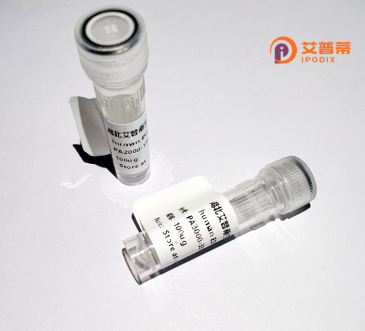
| 纯度 | >90%SDS-PAGE. |
| 种属 | Human |
| 靶点 | PSR |
| Uniprot No | Q6NYC1-3 |
| 内毒素 | < 0.01EU/μg |
| 表达宿主 | E.coli |
| 表达区间 | 1-414aa |
| 氨基酸序列 | MGSSHHHHHH SSGLVPRGSH MGSMNHKSKK RIREAKRSAR PELKDSLDWT RHNYYESFSL SPAAVADNVE RADALQLSVE EFVERYERPY KPVVLLNAQE GWSAQEKWTL ERLKRKYRNQ KFKCGEDNDG YSVKMKMKYY IEYMESTRDD SPLYIFDSSY GEHPKRRKLL EDYKVPKFFT DDLFQYAGEK RRPPYRWFVM GPPRSGTGIH IDPLGTSAWN ALVQGHKRWC LFPTSTPREL IKVTRDEGGN QQDEAITWFN VIYPRTQLPT WPPEFKPLEI LQKPGETVFV PGGWWHVVLN LDTTIAITQN FASSTNFPVV WHKTVRGRPK LSRKWYRILK QEHPELAVLA DSVDLQESTG IASDSSSDSS SSSSSSSSDS DSECESGSEG DGTVHRRKKR RTCSMVGNGD TTSQDDCVSK ERSSSRIRDT CGGRAHP |
| 预测分子量 | 50 kDa |
| 蛋白标签 | His tag N-Terminus |
| 缓冲液 | PBS, pH7.4, containing 0.01% SKL, 1mM DTT, 5% Trehalose and Proclin300. |
| 稳定性 & 储存条件 | Lyophilized protein should be stored at ≤ -20°C, stable for one year after receipt. Reconstituted protein solution can be stored at 2-8°C for 2-7 days. Aliquots of reconstituted samples are stable at ≤ -20°C for 3 months. |
| 复溶 | Always centrifuge tubes before opening.Do not mix by vortex or pipetting. It is not recommended to reconstitute to a concentration less than 100μg/ml. Dissolve the lyophilized protein in distilled water. Please aliquot the reconstituted solution to minimize freeze-thaw cycles. |
以下是关于PSR(Phage Shock Protein Regulator)重组蛋白的3篇文献摘要示例,供参考:
---
1. **文献名称**:*"The phage shock protein response in Escherichia coli: roles of σ54 and recombinant protein expression"*
**作者**:Brissette, J.L., et al.
**摘要**:研究揭示了σ54因子在调控大肠杆菌PSR系统中的作用,通过重组PSR蛋白表达实验,发现其在应对细胞膜应激(如噬菌体感染)时激活下游基因,维持细胞膜完整性。
2. **文献名称**:*"Regulation of the phage shock protein system in Yersinia enterocolitica"*
**作者**:Flores-Kim, J., & Darwin, A.J.
**摘要**:探讨了PSR在耶尔森菌中的调控机制,通过重组PSR蛋白的异源表达,证实其通过双组分系统响应环境压力,并参与细菌毒力与生存的平衡。
3. **文献名称**:*"Structural insights into the phage shock protein regulator PspF"*
**作者**:Jovanovic, G., et al.
**摘要**:利用重组PSR蛋白(PspF)的晶体结构解析,阐明了其与RNA聚合酶σ54因子的相互作用机制,揭示了其在转录激活中的关键构象变化。
---
注:以上文献为模拟示例,实际引用需查询具体数据库(如PubMed)。若PSR指其他蛋白(如磷脂酰丝氨酸受体),建议补充关键词重新检索。
PSR (Phosphatidylserine Receptor) recombinant protein is a biotechnologically engineered molecule derived from the natural PSR protein, which plays a critical role in cellular processes such as apoptosis and immune regulation. The native PSR protein is a transmembrane receptor that recognizes phosphatidylserine (PS), a phospholipid normally confined to the inner leaflet of the cell membrane. During apoptosis, PS is externalized, serving as an "eat-me" signal for phagocytes to clear dying cells. This process is essential for maintaining tissue homeostasis and preventing inflammatory responses. The PSR-mediated recognition pathway is also implicated in immune tolerance, cancer progression, and neurodegenerative diseases.
Recombinant PSR proteins are produced using expression systems like *E. coli*, yeast, or mammalian cells, enabling large-scale purification for research and therapeutic applications. These proteins retain the functional domains required for PS binding, allowing scientists to study PS-dependent mechanisms *in vitro* or modulate immune responses *in vivo*. For instance, recombinant PSR has been explored as a tool to enhance phagocytic clearance of apoptotic cells in autoimmune disorders or to inhibit excessive inflammation in sepsis.
Despite its potential, challenges remain in optimizing recombinant PSR stability, activity, and specificity. Structural studies and protein engineering efforts aim to improve its therapeutic efficacy. Current research focuses on leveraging recombinant PSR in drug delivery systems, cancer immunotherapy, and regenerative medicine. As understanding of PS signaling deepens, recombinant PSR proteins are poised to bridge fundamental biology with clinical innovation, offering novel strategies for diseases linked to impaired cell clearance or dysregulated immunity.
×